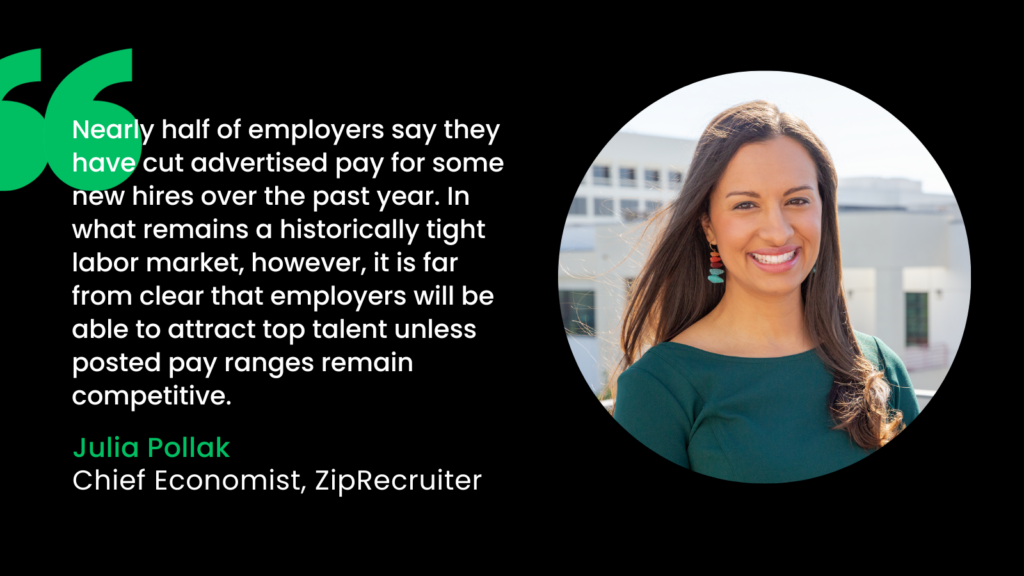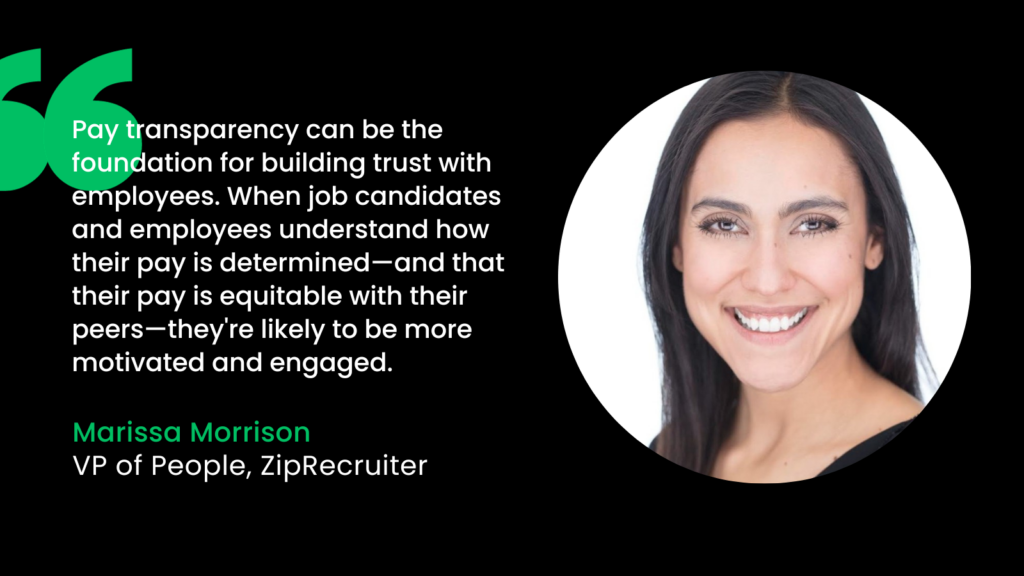The following findings are based on the results of ZipRecruiter’s first Annual Employer Survey, providing an in-depth look into the challenges, motivations, and latest hiring practices of employers across the U.S.
Top takeaway: It is becoming standard practice for employers to publish salary information in job descriptions, but determining the right number to post remains challenging. Almost half of employers have reduced pay for certain roles over the past year, even as 4 in 10 say they are unable to fill vacancies at current wage levels.
Pay transparency laws are driving more employers to disclose salary ranges in job descriptions. That increased transparency is making it easier to observe trends in employers’ wage offers. Right now, the trend is clear: growth in advertised wage rates for new hires is not only slowing— in some cases, it’s reversing. In fact, over the past year, more job titles, industries, and job categories on ZipRecruiter have seen average advertised wage rates decline than increase, reversing the trend in prior years.
To learn more about how businesses are thinking about pay levels and pay communications, ZipRecruiter’s recent annual employer survey asked several detailed questions. Employers reported that pay is the most important differentiator in recruitment and that they feel pressure from candidates to raise pay, with 41% of employers saying that a position has gone unfilled in the past 6 months because candidates want more pay than the company is prepared to offer. Nonetheless, employers are also trying to change employee wage expectations following two years of rapid (nominal) wage increases, with 48% saying they have reset pay downwards for some roles in the past year.
THE MACROECONOMIC BACKDROP
According to data from the U.S. Bureau of Labor Statistics, the average hourly wage has risen 18.5% since the pandemic1—at least, in nominal terms. Over the same period, consumer prices have risen by roughly the same amount,2 so the average real wage has been roughly flat. Had inflation remained consistent with the Federal Reserve’s 2% inflation target, prices would have grown just 7%, and wages 12% (by around 2% a year to keep pace with inflation and an additional 1.4% per year to compensate workers for higher productivity).3 In real terms, then, the average wage now is almost 5% below its pre-pandemic trend.
The result is that many employers believe they’ve given workers unusually large wage increases since the pandemic, and many workers believe they’ve seen their wages stagnate or fall. Both are right, depending on how one accounts for inflation. Since wages and prices do not grow evenly across categories and regions, the picture is even more complicated, with some workers—particularly those in low-wage industries—coming out ahead and others falling behind.
At the same time that rapid inflation and widespread labor shortages were prompting employers to consider extraordinary one-time measures like large signing bonuses and increases to starting pay, several states adopted pay transparency laws that require employers to publish the wage or salary range they reasonably expect to pay upfront in each job listing. The laws have encouraged employers to overhaul their pay policies and adopt more transparent, strategic, and disciplined pay practices at the very moment when they had the strongest economic incentive to do the opposite. We conducted our survey to explore how employers are resolving these tensions.

KEY FINDINGS
Transparency Matters
- Pay Transparency Now Standard Practice—Where Required. 72% of employers surveyed said that they post salary information in all job postings, and only 10% say they do not. But the remaining 18% say they disclose pay only in states where legally required to do so. Small or medium-sized businesses were more likely than major enterprises to say that they post pay (74% vs. 64%). ZipRecruiter marketplace data confirms that pay transparency laws drive a meaningful increase in disclosure, raising the share of postings with pay information from around 20-30% before the laws take effect to around 50-60% afterwards.
- Recruitment Benefits of Pay Transparency. 75% of employers agree that pay transparency helps them attract quality candidates. 61% agree that pay transparency makes recruitment more efficient by discouraging poorly matched candidates from applying and preventing post-offer disappointment. ZipRecruiter marketplace data confirms that job postings that include salary data receive 50% more applications, on average,4 and are three times more likely to deliver quality candidates.5
- Employer Apprehensions Regarding Transparency. 44% of employers worry that pay transparency could discourage top talent from applying for their roles because competitor companies post higher pay. While employers want to avoid publicly posting high wage rates and setting expectations unrealistically high, they also don’t want to set pay too low and deter high-quality candidates from applying. Employers also worry that candidates who see base pay rates published might fail to understand that total compensation is often substantially higher, once benefits and perks are included. Among companies that do not disclose pay upfront, 71% only do so in the course of interviews where they can provide more context.
- Pay Transparency and Pay Negotiations. 64% of employers overall, and 75% of major enterprises, said that candidates frequently negotiate pay. 44% of employers worry that posting pay publicly might tie their hands in pay discussions and reduce their flexibility to negotiate with individual candidates, slowing the recruitment process down.
- The Tension Between External Competitiveness and Internal Equity. 44% of employers say they believe that pay transparency causes conflict internally among existing employees. When labor market conditions are tight, employers face pressure to raise posted pay rates to attract more candidates. But doing so can cause incumbent employees to feel unfairly treated if they do not receive similar upward adjustments. A large share of employers are concerned that transparency could make wage compression between new hires and longer-tenured employees more salient and thereby harm employee morale.
Pay Dynamics in the Current Market
- Job Seeker Wage Demands. 41% of employers said that a position has gone unfilled in the past 6 months because candidates wanted more pay than the company was prepared to offer. That experience was similarly prevalent in major enterprises (44%) and small or medium-sized businesses (40%).
- Resetting Expectations. 48% of companies said they have reset pay downwards for some roles over the past year. Small and medium-sized businesses were substantially more likely than major enterprises to have cut pay (50% vs. 38%).
- From Pay to Perks. Even as almost half of companies have reduced pay for some roles, many have added benefits and perks. 39% said they added health insurance benefits over the past year, 28% retirement benefits, and 26% life insurance benefits. Employers’ self-reported behavior is consistent with ZipRecruiter job posting data showing increased mentions of benefits over the past three years.

Notes
- U.S. Bureau of Labor Statistics, Current Employment Statistics, February 2020–August 2023, at https://fred.stlouisfed.org/series/AHETPI.
- U.S. Bureau of Labor Statistics, Consumer Price Index, February 2020–August 2023, at https://fred.stlouisfed.org/series/CPIAUCSL.
- Between 2013 and 2019, workers became accustomed to receiving a 2% annual increase to keep pace with inflation, and an additional 1.4%3 annual boost to account for productivity growth. Author’s calculations using U.S. Bureau of Labor Statistics, Current Employment Statistics, February 2020–August 2023, at https://fred.stlouisfed.org/series/AHETPI; and U.S. Bureau of Labor Statistics, Consumer Price Index, February 2020–August 2023, at https://fred.stlouisfed.org/series/CPIAUCSL.
- ZipRecruiter Internal Data, Jan.1 to Dec.31 2022. Includes Only ZipApply subscriber jobs.
- ZipRecruiter Internal Data, Jan.1 to Dec.31 2022.
PAY TRENDS CHARTS

Survey Methodology: ZipRecruiter conducted a national online survey between July 7 and August 1, 2023, to explore employer attitudes toward recent hiring trends and their experiences of current U.S. labor market conditions.
The survey was administered to a Qualtrics panel of 2,000+ verified talent acquisition professionals and hiring managers, each of whom has considerable responsibility for hiring processes and decisions. They were drawn from businesses of various sizes across a wide range of industries.
In addition to standard screening and demographic questions, respondents were asked about their recruiting, hiring, employment, and retention practices, as well as their expectations, desires, and requirements for future talent acquisition activities.








